| Design Grand Prix, PROJECTS
Open Doors was a three-hour presentation of project presentations that focus on new uses of pervasive computing. The session was on Friday 15 November (Day Two). The winner Jussi Angesleva won a trip to India to present at the next DoorsEast.
|
|
Jussi Angesleva
Media Lab Europe
Winner page
more links
Body Mnemonics
|
WINNER OF OPEN DOORS DESIGN GRAND PRIX
Body mnemonics is a meta tool for portable devices that enhances their usability, shifts the interaction to the periphery of our concentration and makes them more responsive to our cultural background on the basis of three principles: proprioseptic sense, our outlook on our own bodies, and the “method of loci” mnemonic device.
|
|
Lavrans Lovlie & Chris Downs
Livework
Loome
your personal information broker
more links
livework.co.uk
|
Trading of personal data in between companies is a billion-dollar business. 'loome' enables the average consumer to enter into this market, assemble valuable data and sell their personal information. Regarded by some as 'information prostitution', we see loome as a way to open up a fair exchange between business and the individual consumer regarding the use of personal data.
Lavrans Lovlie graduated from the Rhode Island School of Design in 1994 with a BA in Industrial Design. He has worked as an Interaction Design Consultant, developing businesses, products and services for the new economy for the last seven years. He has been an active part of several successful start-ups in Scandinavia. Lavrans later completed his MA in Interaction Design at the Royal College of Art, and is a founding partner or London-based service design group livework.
|
|
Josephine Pletts & Usman Haque
Pletts Haque
Hardspace and Softspace
|
Pervasive computing encourages users to configure their own spaces -- as people become architects of their own spaces (through their use), the word "architecture" ceases to be a noun: it becomes instead a verb. Architectural interfaces and frameworks can become dynamic events rather than static objects. Space is then defined less by its enclosure and more by the activities that take place within it. The interface between this "hardspace" and "softspace" opens up many poetic possibilities for designers of space. We will demonstrate how this approach can be implemented in an architecture of smell, sound, light, heat and radio.
|
|
Shona Kitchen
Ben Hooker
Royal College of Art
The Altavistas Project
(transcription)
more links www.proboscis.org.uk |
We think there are ways to interface with the complex flows of electronic data that run through our cities so that they can be experienced as an enriching contrast to other, more 'natural' phenomenon. The Altavistas project is a design exploration to test this hypothesis.
|
|

Rein Jansma
Zwarts & Jansma
Interactive Carparcs
|
Near Amsterdam Central Station we designed a large underground parking garage. The parking garage is approximately 500 metres long, and the parking capacity is 1700 cars. A large number of buildings will be constructed over the garage. These buildings will have various functions, such as a library, a music academy, shops and houses, congress rooms and restaurants. The master plan of architect EEA includes a fan-shaped grid. To confirm the identity of the space we have projected swimming fish on the wall adjacent to the water. In order to create an underground space in this setting where visitors can easily find their way and which is safe from a social point of view, we have taken some measures. The staircases facing the street – the garage is situated approximately eight metres below ground level – are inherently unsafe places, which run on into the inaccessible cellar floor of the buildings over the garage. As a safety measure security cameras will be installed. Seeing and being seen gives a sense of security. Ordinary surveillance cameras make one feel spied upon rather than protected; moreover, they do not provide an insight into the situation one is about to enter. Therefore, we will put up large flatscreens at ground level next to the entrances and exits of the staircases, showing the people who are presently inside. Using the video technique ‘difference-key’, people’s images are edited out of their surroundings and superimposed on the image of the swimming fish. This results in an image at street level which is attractive to passers-by, and at the same time enables them to alert the police if necessary. Also, the flatscreens mark the entrances and exits of the parking garage, so there is no need for large ‘Parking’ signs on the façade. A small sign will suffice. Through this intervention, we seek to combine orientation, identity and security.
|
|
|
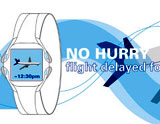
more links
mkieslinger.asp
|
Michael Kieslinger
Interaction Design Institute Ivrea
Fluidtime
In an increasingly networked world,we are faced with growing options and demands from the services, products and people with whom we interact. The natural rhythm of our experience is restricted by the rigidity of clock-based schedules. Our interactions are fraught with concerns about time: is my doctor late, my bus coming, my package en route? The fluidtime service provides people with real-time information about their environment, allowing people to adjust their schedules in relation to their surroundings, and to live in a new, more flexible way.
|
|
Doris Zoller
Temporary Private Zone
(sorry, no link available) |
The study of the techno scene and its new nomadic event structure is the basis of the research for theTemporary Private Zone (TPZ). The TPZ is an attempt to describe and analyse this new nomadic urbanism. The TPZ demonstrates a view of the contemporary city which is highly complex and built up of many layers. The TPZ is highly influenced by the latest technology. New informational networks in combination with advanced digital devices are used to navigate and move through the city in different ways. The emerging nomadic urbanism is a result of a complex interplay of mobility and these new informational networks, each reinforcing the other. The TPZ is offering three main design principles: the ephemeral, new design tools and the active participation of the city user. The ephemeral is the basic characteristic of the nomadic structure of the TPZ. New design tools are on the one hand new informational systems including advanced digital devices, and on the other hand new non-physical construction materials. The user of the TPZ is becoming an active participant in creating this new urbanism, and is therefore the main and most important force to create the TPZ.
|
|
Pedro Sepulveda
Royal College of Art
Digital Shelters
|
A new landscape is emerging in the urban space, a Scanscape that transgresses the boundaries and protocols of public and private space due to the extensive use of electronic, surveillance and telecommunication technologies in the urban realm. How can we define these Scanscapes? How can we create Digital Shelters that will protect us, isolate us or allow us to live with in these Scanscapes? Digital Shelters is a research project that reveals and maps these new Scanscapes that we inhabit. It proposes a design approach based on the collection and analysis of events, accidents and DIY design in everyday life that will reposition the role of electronic spaces and objects as a main part of this new urban condition.
|
|
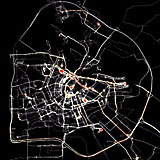
|
Esther Polak, Aske Hopman
Waag Society
Amsterdam Realtime
A special live map of Amsterdam is part of a current exhibition in the city's Municipal Archives: Maps of Amsterdam 1866-2000. Ten inhabitants of Amsterdam per week carry a GPS tracer with them in the period 4 October - 1 December 2002. They participate in a real time mapmaking project in which their routes through town are made visible on a projection screen in the exhibition space: Amsterdam RealTime, diary in traces. The participants are asked to go about their normal daily business and switch on the GPS tracer when they are 'en route'. The traces on screen form an alternative, highly personal map of the city. This is a joint project of Waag Society's Tom Demeyer, Marleen Stikker and Aske Hopman with artists Esther Polak and Jeroen Kee. |
|
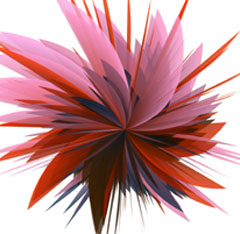 |
Casey Reas
MIT Media Lab
Living Surfaces (transcription)
a future of textile and surface design
A desire is emerging in our culture to adorn ourselves with responsive photographic fabrics and technologies are being to developed that may lead to the realization. I will present five designs for future fabrics and discuss examples from fiction, technology, and fashion that demonstrate precedent for this inevitable material.
more links
acg.media.mit.edu/people/creas/
|
|
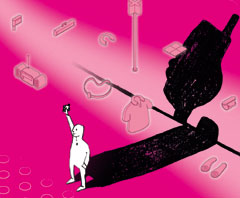 |
Analia Cervini & Juan Kayser
Interaction Design Institute Ivrea
Mobile Embodiments.
Pervasive computing as the future body for mobile devices. In a future where people will just carry an incredibly connected device, our concern is not so much the provision of more intelligence and functionalities, as it is to find the way to give body and significance to its potential use. We are imagining a scenario where technologically enriched environments will enhance our experience with this tiny object. Our vision is that the mobile device could benefit from its immediate physical environment as a material extension of itself. As this powerful brain finds bodies that facilitate new ways of expression, our daily experience of connectivity is enriched in value and meaning.
more links
/people/acervini.asp
|
|
Willem Minderhout
Atos Origin
New Arcania (transcription).
more links
www.nieuw-arcanie.nl/
|
Nothing flows like water/water mixes everything
We have ‘imagined’ a deliberative decision making process which resulted in a nation wide plan to give the rivers more room. In the newly created marshlands, not only new nature is created, but also nodes floating urban realms: New Arcania. New Arcania is not visioned as ‘just a fleet of arcs’, but as a living, flexible community which is supported by digital networks for social economical, cultural and administrative processes.
|
|
Femke Wolting and
Bruno Felix
Submarine
Crisis
|
Crisis is an multiplayer game via the internet, sms and television. Holland is heading for a disaster. Political Leaders join forces to cope with the crisis. In the television show well-known prime ministers and are taking up the challenge to keep an emergency situation under control. In the Internet game viewers become the crisis managers themselves and find out how a crisis situation in real life should be solved. Using news broadcastings, radio reports and news paper articles on the website news players can follow actualities and recent developments. Through SMS and e-mail they receive the latest news and are asked in urgent situations to to vote and participate in the game. |
|
Gary McDarby and
John Sharry
Media Lab Europe
Mindgames
|
In Mental Leaps we look at how state of the art non-invasive brain computer interfaces and real-time signal processing, powerful sensory immersion and compelling gameplay are designed for a player to make the ultimate mental leap in gaming- letting go of the joystick and playing the game with their mind. By having more control over various brain-states could we use this kind of technology as a way of treating conditions like attention deficit, depression and anxiety disorders? In this talk we explore how the MindGames group (based in Media Lab Europe), through its multi-disciplinary approach to research is tackling this issue. |
|
 |
Victor Vina
Interaction Design Institute Ivrea
Design your own Network
Through a collection of modular, wireless objects, this proposal encourages the creation of self-regulated, distributed, personal networks. Rather than presenting the ultimate solution, it provides an open platform, raising a number of questions about the meaning of information structures. It encourages reflection by presenting a physical abstraction of the elements of a network.
|
|
Lizbeth Goodman
SMARTlab Centre,
Central Saint Martins
Flutterfly
|
A case study centring on a 'flutterfly' performance on 'flow theory' and visualisation of performance dynamics and collaborative energies between artists and scientists. In Flutterfly a dancer dances with a wheelchair dancer, an animated butterfly and a robot, all as one becoming the butterfly that flies up when they release the 'chaos' of the dance into a lyricism at a higher level, showing how our notions of 'chaos' energy in movement and collaborative energy studies can be worked through in flows and waves
|
|
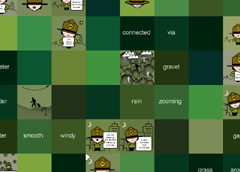 |
Scott Paterson
Eyebeam Atelier.
Pdpal
Translocation describes a way of creating global connections through an emphatic articulation of the local or many locals, which can be quirky, fractured and sometimes fractious. PDPal, our project for the PDA and web, experiments with both hybrid and new expressions of space/place and individual/communities in a highly mobile - and motile - form . PDPal operates on three interwoven trajectories which , when experienced together, approach the idea of a "communicity: " a made-up city of individuals who share a subjective and poetic language with which to express their local(es) in ways that can render visible the invisible.
|
|
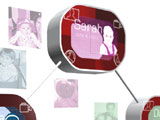
more links
www.fioriinc.com |
Pat Rodden
Fiori
My Life (transcription)
Humans have a very basic, instinctual desire for immortality, embodied in our historical efforts as a species to "leave our mark" and share our individual experiences with a greater community. Cavemen scratched pictures into rock walls. Painters create beautiful representations of reality. Photographers capture a moment. Journals are written. Parents collect hours upon hours of video of their newborn child's formative years. Internet-saavy individuals and web-addicts mount web-cameras to their home PC's and allow others to participate in their daily lives as a passive audience. In many cases, we choose to record moments or segments of our lives not only as a way of building connections with other people, but also as a way of giving ourselves the opportunity to reflect upon our own lives. In the near future, people will use pervasive computing technology to fulfill this basic human desire. |
|
Marc Neelen
Ana Dzokic
Milica Topalovic
Stealth
Wild City
Genetics of Uncontrolled Urban Processes
|
The observation starts from the reality of Belgrade, the 2 million inhabitants’ capital of Yugoslavia. Belgrade is a city that recently experienced an abrupt change from a centrally conducted to an atomised growth as the result of a decade of crisis. The trigger for the metamorphosis of the city was given by a United Nations embargo in 1992, amidst an atmosphere of war traumas, media obsession and politicisation. While the cities’ planning institutions during this period lost their power, private initiative started to take control over the new developments in the city.cIn this context, as a compensation for the collapsing state and institutions, the unleashed individual action started to produce innovation in literally every urban domain - from commerce, to housing production and public services. A new, non-regulated structure appeared, flooding the public spaces and superimposing as a layer of mutants on top of the existing city. The research of urban genetics focuses on the evolutive, time-based character of non-regulated transformations. It is a practice of discovering the inherent logic of emergent processes, under a hypothesis that their outcomes are often more sophisticated than the conventionally designed ones. |
|
Florian Thalhofer
Willem Velthoven
Mediamatic
Korsakow syndrom |
The Korsakow Project is an ongoing research and development project at the university for the Arts in Berlin. We are developing a very easy to use authoring environment for interactive narration. It's a database-driven Quicktime matching engine for storytelling that enables a broad range of narrative strategies.
|
|
Liselott Brunnberg
Mobility Studio / Interactive Institute
Backseat Gaming
|
The backseat gaming prototype is a mobile augmented reality game. The aim of the prototype is to explore how to use changing scenes and the sense of motion in a highly mobile situation,that of a car passenger to create a compelling game situation. The prototype is realized by the use of mobile technology and the users physical location to merge the virtual content and surrounding road context. In addition to location, we also introduce variables such as speed, direction, timing, changing surrounding, fast movement of manipulative objects and multiple entry and exits. |
|
Alexander Grunsteidl
Marcus Gosling
IDEO
Cameras wide shut
|
we will be taking the extrapolation of technology trends to an extreme. what will be the design strategies and social implications of optical sensing technologies similar to cameras, when they will be as readily available as existing pervasive technologies like electric motors and light sources in our everyday environment?
|
|
Open Doors Design Grand Prix Jury
Deyan Sudjic (Domus, The Observer)
Petra Schmidt (Form)
Brenda Laurel
Chee Pearlman (correspondent of Wired and New York Times)
Sascha Kösch (De:Bug)
Ole Bouman (Archis)
|